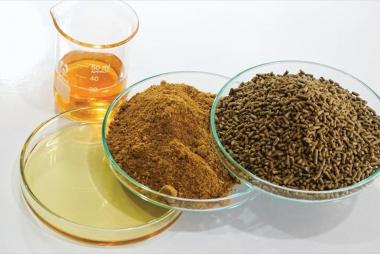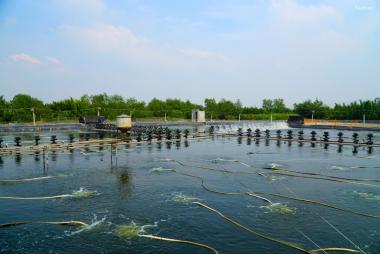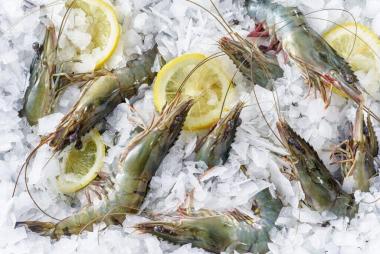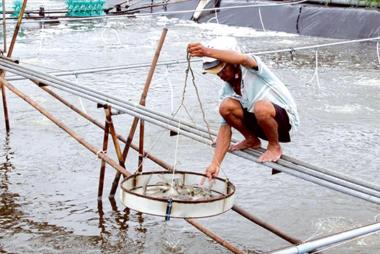- Address: Lot No. 20, Zone G, D1 Street, An Ha Industrial Park, Tan Vinh Loc Commune, Ho Chi Minh City
- Phone: (84-28) 668.36156 / 668.36158
- Hotline: 1800.9435
- Fax: (84-28) 3620.4694
- Email: vibo@vibo.com.vn
- Website https://vibo.com.vn/

Ca Mau scales up recirculating, biosecure shrimp farming with RAS
According to the Department of Science and Technology of Ca Mau province, RAS-IMTA technology is emerging as one of the key solutions to reduce environmental pollution and strengthen the competitiveness of Vietnam’s shrimp industry. Thanks to its proven efficiency in cost control, productivity and environmental protection, this model is considered suitable for large-scale expansion, especially in Ca Mau’s concentrated shrimp farming zones.
What is RAS-IMTA?
RAS-IMTA is an advanced aquaculture model that combines Recirculating Aquaculture Systems (RAS) with Integrated Multi-Trophic Aquaculture (IMTA) to form a closed, environmentally friendly polyculture ecosystem.
The system allows:
-
Recirculation of water and nutrients between different cultured species
-
Reduction of waste discharge and environmental load
-
Higher productivity per unit area
-
Generation of value-added products (fish, seaweeds, etc.) alongside shrimp
This approach supports both biosecurity and circular economy principles, aligning closely with Vietnam’s green aquaculture roadmap.

Pilot project: Three-phase super-intensive whiteleg shrimp farming
The pilot project titled “Developing a three-phase super-intensive whiteleg shrimp farming model using biosecure, low water-exchange recirculating technology” has been implemented in Ca Mau since 2023.
By October 2024, the project was officially recognized as excellent by the Ca Mau Provincial People’s Committee under Decision No. 206, confirming its technical and economic feasibility as a scalable model for the province.
Scaling up clean, biosecure shrimp farming across Ca Mau
Building on the initial success, Ca Mau is now moving to expand clean shrimp farming across the province. The Department of Science and Technology is implementing a new project:
“Mobilizing resources to expand the biosecure, low water-exchange, super-intensive recirculating whiteleg shrimp farming model in Ca Mau province.”
Key features of this scale-up project:
-
Duration: 24 months (January 2025 – December 2026)
-
Scope: 12 communes, including:
Ly Van Lam, Ta An Khuong, Quach Pham, Luong The Tran, Dam Doi, Cai Nuoc, Hung My, Phu Tan, Cai Doi Vam, Nguyen Viet Khai, Dat Moi and Nam Can.
The goal is to broaden adoption of the RAS-IMTA model, mobilize investment resources, and create a synchronized, biosecure farming network across Ca Mau’s core shrimp areas.
Mid-term review: Performance beyond expectations
To evaluate and accelerate the expansion of the model, the Ca Mau Provincial People’s Committee recently held a conference titled:
“Mid-term review and acceleration of the biosecure, low water-exchange, recirculating super-intensive whiteleg shrimp farming model (RAS-IMTA).”
According to reports presented at the conference:
-
Registered area under the project: more than 111 hectares
-
Area already in production: 47 hectares across 10 households, with several households entering their second crop and preparing for the third
-
Detailed results from two repeated crop cycles (28 hectares):
-
Average stocking density: 180 PL/m²
-
Farming period: 85 days
-
Average survival rate: 72% (maximum 76%)
-
Harvest size: 30 pcs/kg
-
Yield: 35.3 tons/ha/crop
-
Profit margin: 60.8%
-
With these outcomes, the model has:
-
Achieved 81% of the planned yield target
-
Reached a 100% crop success rate
-
Delivered a profit margin of 60.8%, which is 7.8 percentage points higher than the original target
These figures confirm that RAS-IMTA is not only technically viable but also financially attractive for shrimp farmers.
Key advantages of the RAS-IMTA model
The conference highlighted several major strengths of the RAS-IMTA super-intensive shrimp farming model:
-
Significantly reduced discharge to the external environment
-
High adaptability to existing farm infrastructure
-
Ease of application and replication for farmers
-
Strong alignment with green aquaculture and circular economy strategies
The polyculture component is a central feature of the model. By combining tilapia and seaweeds (such as Gracilaria tenuistipitata and Enteromorpha spp.) with shrimp:
-
Water quality is improved and stabilized
-
Production costs are lowered through natural biofiltration
-
Farmers can diversify harvest products beyond shrimp
-
Overall farm income increases thanks to multiple revenue streams
Local leadership: A foundation for “reviving” shrimp farming
Mr. Le Van Su, Vice Chairman of the Ca Mau Provincial People’s Committee, emphasized the strategic importance of the model:
“The biosecure, low water-exchange, super-intensive recirculating whiteleg shrimp farming model (RAS-IMTA) has the potential to create a breakthrough in the future development of the province’s shrimp industry. Therefore, we call on all departments, local authorities, businesses, and farmers to join forces in effectively expanding this model, as a foundation to ‘revive’ shrimp farming in particular and the fisheries sector of the province as a whole in the coming time.”
With strong support from provincial authorities, clear economic benefits, and compatibility with green, high-tech aquaculture, the RAS-IMTA model is set to become an important pillar in Ca Mau’s strategy to upgrade and modernize its shrimp industry.
Translation from VIBO news. Author of Vietnamese article: Adapted from VASEP (seafood.vasep.com.vn).














